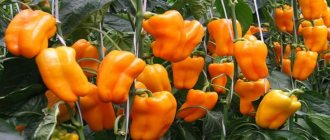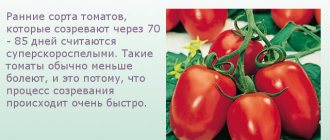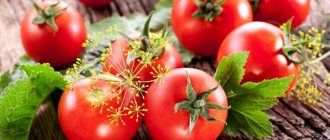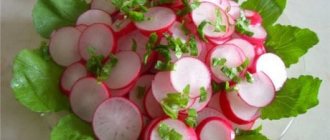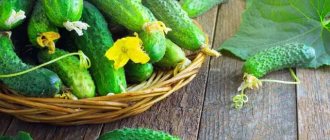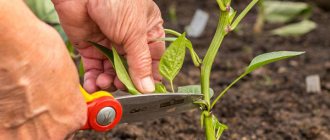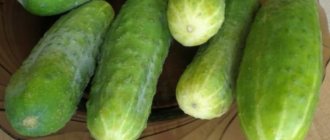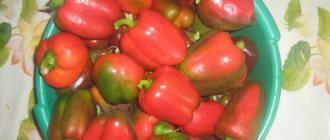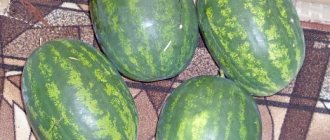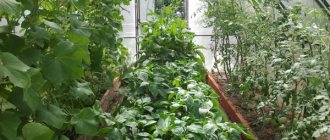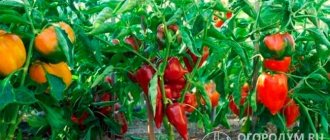Every self-respecting gardener strives to grow a rich harvest of bell pepper on his plot. Increasingly, preference is given to tall varieties of this heat-loving crop.
It is best to grow indeterminate peppers in a greenhouse, since its conditions are closer to the “native” ones for this vegetable. In addition, tall varieties compare favorably with short ones in that they produce very large fruits. Peppers ripen in time, and the fruiting of tall peppers lasts much longer. Well, who would refuse the temptation to get several kilograms of delicious, selected fruits?
Recommendations for growing tall peppers in a greenhouse
If you want to grow indents indoors, you should take into account some nuances. Firstly, bell pepper is a warm and light-loving crop. Therefore, pepper beds need to be provided with an optimal temperature at which the plants will feel “at home.” Also, especially in the northern regions, it is important to provide the greenhouse with artificial lighting and turn on the lamps in cloudy weather.
Secondly, tall types of pepper are distinguished by unlimited growth of the bush, powerful stems, and strong foliage. During the growing season, numerous clusters bloom profusely and massively form dozens of fruits that pull the branches down. To prevent branches from breaking, care must be taken to install reliable supports and properly tie up the main trunk of the plant and overloaded parts.
Thirdly, even being in seemingly ideal conditions, bell peppers will ripen according to the stated ripening dates. No amount of fertilizing or other manipulations will make, for example, a mid-late variety into an early variety. All that can be done is to protect the pepper bushes from all sorts of unfavorable factors and wait for a harvest that will be tasty and stable.
Top 4. Honey King
Rating (2021): 4.72
Best taste Many vegetable growers consider this variety to be one of the best. Fleshy walls, high sugar content and a bright peppery aroma make it very tasty.
- Characteristics
Bush: up to 50 cm
- Ripening: 100-115 days
- Fruit weight: 180-200 g
- Wall thickness: 8-10 mm
- Yield: up to 11.5 kg/sq.m
One of the ultra-early ripening varieties pleases with the first ripe peppers already in mid-July. The compact but powerful plant produces many ovaries. In the greenhouse, the peppers have time to fully ripen, gain sweetness, and take on the color characteristic of the variety. The fruits are elegant - bright yellow, smooth, cuboid in shape. Each weighs up to 200 grams. Fleshy walls up to 10 mm thick contain a lot of sugars and have a pronounced aroma. “Honey King” is a hybrid with enviable resistance to cold weather and temperature fluctuations day and night. Due to its low height, it does not have to be tied up. You need to put in a minimum of effort, and the harvest is always pleasing. In the greenhouse it is possible to collect up to 11 kilograms per square meter. But this is subject to timely watering and regular fertilizing.
Advantages and disadvantages
- Compact bushes
- Yield variety
- Cold resistance and early ripening
- Thick-walled fruits
- Vulnerability to disease
Buy on agrosemfond.ru
How to get a good harvest:
- buy only high-quality seeds from trusted manufacturers;
- Seed material must be treated to prevent it from being affected by various diseases. You can also soak them in a growth stimulator so that shoots appear a few days earlier;
- Sowing should be done no earlier than March. By the time of planting in the ground, seedlings should be 60-65 days old;
- seedlings should grow in a nutritious, light, well-moistened environment;
- peppers grow healthy only at temperatures not lower than 22 degrees Celsius;
- feed the seedlings on time;
- By the time of planting in the garden, the bushes should have at least 5-6 leaves. Do not allow the seedlings to overgrow when the first flowers appear on them;
- Follow the planting rules, leave at least 40 centimeters between the bushes. Fungal diseases often develop in dense plantings;
- be sure to shoot and shape the plants, otherwise a jungle will grow in the greenhouse;
- Water the peppers on time and correctly. Avoid excessive moisture in the soil and air;
- ventilate the greenhouse;
- loosen the soil regularly. Sweaty soil does not allow water or oxygen to pass through. In such conditions, the roots quickly die;
- when the bush grows to a height of 100-120 centimeters, pinch the top, this way you will direct all the forces of the plant to the formation of fruits;
- nourish the plants, so they will reward you with an abundance of large fruits.
Features of choosing a location and soil
Pepper is a plant that loves light and warmth.
Another important detail is soil moisture. It should not be too dry or too wet. The soil for planting is medium loamy, sandy loam, or black soil.
Before planting, seeds are sown in small containers in advance and placed on sunny windowsills. They do this in mid-March.
Seedlings are periodically hardened off (by opening the window).
The soil in the containers is constantly loosened and watered. The sprouts are transplanted into open ground in the second half of May. It is important to know: planting peppers in open ground is the most suitable option.
But, before planting, it is necessary to familiarize yourself in detail with the characteristics of the culture. Otherwise, it is impossible to get a good harvest. If by this time the first buds appear on the sprouts, then everything has been done correctly. All varieties of pepper in open ground are planted in two rows. The beds are made almost 1 meter wide.
The best varieties of tall peppers
Today, there are hundreds of tall varieties, differing in the timing of fruit ripening, the size of peppers, their color and purpose. When choosing a suitable variety, we recommend relying on these criteria and then the result will definitely please you. Below are descriptions of varieties and hybrids that are widespread among our compatriots due to a set of positive characteristics.
Merchant
An interesting variety of sweet pepper with many advantages, one of which is its early ripening. The first peppers appear three months after sowing, and by the hundredth day you can already enjoy them. It is noteworthy that in greenhouse conditions, peppers ripen a little earlier, so if you want to get an earlier harvest, it is better to plant them in a greenhouse.
Merchant pepper is semi-determinate. Its bushes grow 80 centimeters high when growing in open ground, and stretch up to a meter in a greenhouse. The branches of the plants grow powerful, with a lush green crown. They spread widely to the sides, so the plants look more like shrubs than pepper bushes.
The peppers themselves have a classic cone shape. They are located on bushes drooping, weighing down the loaded branches with their weight. The weight of peppers varies between 70-100 grams. Outwardly, they are very attractive - the peel is thick, shiny, and when fully ripe, evenly turns a bright red color. The flesh of the peppers is juicy, sweet, and refreshing.
This variety of pepper is very tasty fresh, but it will also be an excellent addition to any main dish.
Peppers are good for canning and stuffing. By the way, merchant peppers can be frozen - after defrosting they do not lose their shape, taste and aroma. Fact: “Kupets” pepper has a high content of vitamin C and ascorbic acid.
The variety is suitable for cultivation in regions with cool and unstable climates. Merchant is one of the most unpretentious and reliable peppers, which will give a good harvest even with minimal care. So, you can collect 3-3.5 kilograms of peppers from one square meter, and if you follow all the rules of agricultural technology, then from the same meter you get up to 11 kilograms of useful product.
In addition, its obvious advantage is its stable immunity to various diseases. Peppers can be stored for months in a cool, dark room, and their presentation does not deteriorate during long-term transportation.
Atlant F1
Another bright representative of the pepper family, which is characterized by its large fruit. Peppers grow up to 26 centimeters in length and weigh 200-400 grams each. The shape is pyramidal with clearly defined edges - very suitable for stuffing. Peppers are characterized by a bright red color of medium-thick skin, which has a dense, smooth structure. The pulp is dense, juicy, with a large number of seeds. The taste is delicate and sweet, with a pleasant aroma. Due to the increased juiciness of the fruit, amazing healthy juice can be made from Atlant peppers.
The juiciness of the fruits of the Atlant variety makes it possible to produce juice from it, which can be used for medicinal purposes.
Fact : since Atlant F1 is a hybrid, it is impossible to grow offspring of the same quality from the collected seeds.
Atlanta bushes are low (1 meter) and very compact. Strong trunks are overgrown with powerful large leaves that create strong shade. Therefore, it is recommended to plant peppers at a respectful distance from each other, placing no more than four plants per square meter. The bushes must be formed into two stems and must be tied to a support.
Atlant is a high-yielding variety. From one square meter you can often collect up to 5 kilograms of huge fruits (in open ground), and if you try, you can even get a double harvest.
Atlant pepper is a mid-season variety. Intensive fruiting occurs exactly four months after sowing the seeds for seedlings.
Fact: Atlant peppers have a very low calorie content - only 27 kcal per 100 grams.
The undeniable advantages of pepper, which, by the way, are valued not only by gardeners, but also by industrial farmers, include the possibility of long-term storage of peppers without compromising their commercial qualities, as well as resistance to mechanical deformation. Peppers of the Atlant variety can be grown both in open areas and in protected ground.
Plants produce a full harvest even in the northernmost regions of the country. Caring for Atlant peppers is minimal. All they love is warmth, humidity, good lighting and timely fertilizing.
Orange miracle
The variety with the unusual name Orange Miracle is not named so by chance. Produced by Dutch breeders, this variety of pepper is endowed with wonderful characteristics, which include the bright orange color of huge and very tasty fruits.
Pepper Orange Miracle is a hybrid. Designed for cultivation in greenhouse conditions, however, in the southern regions, gardeners successfully grow it in open ground.
Orange Miracle is an early ripening variety. The fruits fully ripen in 125 days, but they reach technical ripeness at which they can be consumed in 100 days.
Plants of the variety are considered indents, that is, tall, and often grow up to a meter or a little more in height (in greenhouse conditions). The bushes are branched and spreading, and therefore look quite powerful and voluminous from the outside. Requires tying to support and shaping.
The fruits grow massive and weighty. The average weight of pepper is 250-300 grams. They grow drooping on the bushes. Each bush produces up to 12 powerful peppers. The fruits themselves are cube-shaped. They have a thick, tight skin that takes on a sunny hue when ripe.
Fact: Orange peppers contain vitamin A.
Gardeners choose Orange Miracle for their plots primarily because of the incredible yield of the variety. From one square meter on which 3-4 plants grow, it is possible to harvest up to 14 kilograms of crop. All peppers are fleshy, of the same shape and size. They are ideal for table decoration, and their excellent fresh and juicy taste can transform any dish.
The orange miracle is popular among large agricultural enterprises. Peppers are great for sale, since there is no hassle with their transportation and storage. The harvest can be stored for weeks without losing its shape or taste. In addition, the variety has low sensitivity to many typical pepper diseases, including viral ones.
As befits all hybrids, the Orange Miracle withstands various adverse weather conditions, temperature changes and cold snaps. Even with a lack of sun, the plants set fruit well and bear fruit throughout the summer.
California miracle
For two decades, “California Miracle” has remained one of the most sought-after tall and large-fruited varieties not only in our country, but throughout the world. Over the years of cultivation, the variety has absorbed all the positive qualities. Having virtually no drawbacks, it is successfully cultivated by large rural firms, seasoned summer residents, and new gardeners.
For reference: it is believed that this variety arrived in Russia from America. It was bred there more than a hundred years ago. Today, almost all seed companies offer seeds of this variety with their own variations. The California Miracle also has other names: “California Miracle” and “California Wonder.”
California miracle is a variety with a mid-early ripening period. The fruits begin to ripen by the 110th day from the moment of sowing. At the stage of technical ripeness, at which peppers can already be added to food, the fruits are colored light green. Upon reaching biological maturity, the skin turns bright red. True, the ripening of these peppers takes a little longer than other varieties. Peppers are cube-shaped with a lobe-like structure. The crust is smooth and shiny, very thick. The pulp is fleshy, juicy and sweet. Fruit weight is 80-130 grams. Thanks to their optimal size, peppers of the “Orange Miracle” variety can be stuffed, rolled into jars, and pickled.
Plants often grow no more than 70 centimeters in height. The plants are overgrown with abundant dark green foliage. Despite their rather modest size, the bushes produce powerful stems and branches that can support up to 15 large fruits. When converted into kilograms, each bush can bring up to 4 kilograms of tasty harvest.
Fact : the fruits of the Orange Miracle variety have a specific taste. When added to pickles and marinades, their tart peppery flavor is fully revealed.
The characteristics of the California miracle are such that peppers can be grown in open ground even in central Russia. True, in the northern regions it is still possible to arrange pepper beds in a greenhouse.
Tip: plants of this variety are demanding of sunlight. Every day they need at least 12 hours of lighting - this will stimulate earlier and more vigorous fruiting.
California miracle is a stress-resistant variety. Plants can safely withstand bad weather, extreme heat and infrequent watering. Low susceptibility to various diseases, including verticillium wilt and tobacco mosaic virus, makes California Miracle so easy and fun to grow.
This is interesting : the classic variety “California Miracle” has red fruits. However, today breeders offer peppers of the same variety, but in different colors - yellow, golden, orange and even black.
Miracle Tree F1
Another worthy hybrid, the plants of which look like a small tree. Plants are distinguished by strong growth and often reach 170 cm in height. The stems and branches are covered with lush vegetation, in the thicket of which small pepper fruits are formed. Each bush produces up to 20 juicy sweet peppers. For more successful cultivation and resulting in a bountiful harvest, it is recommended to form bushes into two trunks.
Peppers of this interesting variety are shaped like small prisms. They have a dense, medium-thick skin, which, when the fruit is fully ripe, acquires a bright red color. The pulp is very tender and juicy. The average weight of peppers is 100 grams.
Tip : the fruits of the Miracle Tree variety add a balanced taste to any dish.
The hybrid is considered early ripening. Peppers need only 90-95 days from the date of the first shoots to ripen. At a time when other varieties are just beginning to bloom, the bushes of the “tree” are already strewn with miniature peppercorns. Plants begin to bear fruit at the same time and set fruit until the beginning of autumn. If you remove peppers from the bush at the stage of milky ripeness, then new ovaries immediately begin to form in their place. So, you can get a more worthy harvest, the indicators of which sometimes exceed 6 kilograms from one bush.
Another remarkable feature of the miracle tree is its enviable resistance to many putrefactive and fungal diseases. Hybrid plants are quite easy to care for, because even with a lack of sunlight and short-term temperature changes, the plants knit well.
Tip : It is best to grow the F1 miracle tree in a greenhouse.
Cockatoo F1
A hybrid variety of pepper with a far from peppery name “Kakadu” is so named because of the similarity of the fruits to the shape of the beak of the bird of the same name. The cockatoo has truly enormous fruit sizes - up to 28 centimeters. They stretch into a cone-shaped, slightly curved shape. The weight of each pepper is 400-500 grams. The fruits of the Kakadu variety ripen quite early. The growing season lasts on average 100 days. At the stage of technical ripeness, the fruits are colored green, which changes to bright red when ripe. Peppers grow large and have a cylindrical shape. Their pulp is very juicy, with thick and dense walls. The taste is sweet and aromatic.
For reference: peppers of this variety are used for processing, preservation, and preparation of lecho.
The bushes of the variety are tall, often reaching a height of one and a half meters. The leaves are tied a lot. The leaves are large, lush, dark green. However, in terms of their structure, the plants are compact and quite stable, and therefore do not require support or garter.
The yield of the variety is impressive - up to 5.5 kilograms of tasty fruits are harvested from one bush over the entire season.
Also, the obvious advantages of the variety include its resistance to various putrefactive diseases and tobacco mosaic.
Tip : Kakadu plants need plenty of sunlight. Therefore, it is preferable to grow peppers in a greenhouse with 24-hour lighting.
Hercules
Many summer residents prefer to grow thick-walled and large-fruited peppers. In addition, it is preferable that the variety has good vitality, because in Russia it is difficult to find an optimally suitable climate for such a heat-loving crop as bell pepper. All these characteristics suitable for successful pepper cultivation have been optimized into one beautiful variety called “Hercules”. This worthy variety was selected by domestic specialists, and this is probably why it has a number of properties useful for cultivation in our country.
Reference: another name for the variety “Hercules F1”.
Gardeners love this variety with the loud name Hercules for its unusually large, powerful, thick-skinned fruits, which at the stage of biological maturity take on a rich red color. The length of peppers often reaches 13 centimeters, and their weight fluctuates around 200-300 grams.
Peppers have an even cubic shape with aromatic, juicy, fleshy and sweet flesh without bitterness. Thanks to their excellent taste, peppers can be used as you please: they are eaten fresh, added to various dishes, pickled, frozen, stewed. And in any form, Hercules peppers will show their rich peppery taste.
You may be interested in: Favorable days for planting pepper for seedlings in 2022: terms and rules for sowing at home Favorable days for picking pepper in 2022 according to the lunar calendar Favorable days for sowing sweet and bitter pepper for seedlings in 2022
Hercules belongs to the mid-early varieties. The first fruits are ready for consumption three months after planting the seeds. Pepper bushes grow short (on average 50 centimeters) and stocky. The plants are richly strewn with dark green foliage, which creates additional shade under the bushes. Each bush bears an average of 8-10 heavy fruits.
The productivity of Hercules is also considered a clear advantage of the variety. If you properly follow all the rules of care, you can get up to 5 kilograms of useful fruits from one square meter.
Fact: the few disadvantages of this variety include a rather long period of fruit ripening.
Gardeners love this variety not only for the high quality of the fruits and the abundant fruiting of the bushes. In addition, the variety has powerful immunity to various diseases. Plants withstand unfavorable external factors. Ripe fruits are stored for a long time - their appearance and taste always remain unchanged.
Chord F1
The leader among hybrid varieties of sweet pepper is this wonderful pepper – Accord F1. Its many advantages include early fruiting, high yield and large fruit.
Reference : the hybrid was included in the State Register of the Russian Federation in 2003.
Hybrid plants are determinate. The trunk grows strong and strong, it holds well the spreading branches, which are gradually overgrown with lush foliage. Among the abundant greenery, drooping fruits form, the number of which on a bush sometimes reaches 10-12 pieces.
The fruits reach technical ripeness 115 days after sowing the seeds. At the “milk” age, peppers have a light green, slightly yellowish tint. And when fully ripe, the rind acquires red shades with dark inclusions.
The fruits have the shape of a blunt cone. They are quite voluminous, weighing up to 180-200 grams. The peel is thick, shiny, ribbed. The pulp is juicy and sweet.
The hybrid bears fruit at the same time, not stretched. All fruits ripen together. When planting plants according to the scheme of 5 bushes per square meter, you can harvest up to 10 kilograms of useful harvest.
It is useful to know that the hybrid is endowed with such a wonderful property as to resist all common diseases, such as the tobacco mosaic virus, which affects most pepper varieties.
Hybrid Accord F1 is very heat-loving. It can grow in open ground, but it feels better in a safer place - a greenhouse. The optimal temperature for proper plant development should be 25-28 degrees Celsius. You will also have to add additional lighting to the plantings if the weather is cloudy outside for a long time.
Accord peppers have excellent keeping quality and excellent taste, for which these peppers have been valued among Russian gardeners for 15 years.
Claudio F1
A well-known Dutch hybrid that has remained in demand for more than 20 years. Its popularity is not surprising - peppers of this variety have excellent external and taste qualities. In addition, as befits hybrids, Claudio is protected from all kinds of diseases and pests. But these are not all the advantages of this variety.
The Claudio hybrid can be grown in various conditions: it shows its excellent productivity, growing both outdoors and under film. In Russia it is cultivated quite widely both in the south and in the north.
Fruiting of plants occurs under different weather conditions at different times. If the vegetable is cultivated in more southern latitudes, then the first peppers enter the technology stage 105 days after the appearance of the first shoots. In mid-latitudes, the growing season lasts somewhat longer, so the name “mid-late” is preferred for the variety.
Claudio plants are medium-sized, highly branched, 70-120 centimeters high. The foliage is large, bright green, slightly rough. Despite the fact that the trunk of the bush is very strong, the plant still requires mandatory garter, since heavy fruits can break the branches. Each bush produces up to 10 large fruits.
The appearance of the resulting fruits is captivating. Peppers are cube-shaped with clearly defined edges. At milk maturity, they turn dark green, emerald, which over time turns into dark red with black stripes along the entire surface. The weight of an average pepper is 150-170 grams, but most peppers weigh 200-250 grams. The skin of hybrid fruits is thick - its thickness exceeds one centimeter. The surface is glossy, smooth, durable, crispy when broken. The inside is juicy, fleshy, sweet with a slight bitterness, which gives the fruits of this variety a special piquancy.
The list of advantages of this hybrid also includes very high plant productivity. In the southern regions, yields often reach 350 centners per hectare. The fruits are of high commercial quality and can be stored for up to two months.
The hybrid has excellent vitality: the plants can withstand extreme heat, sudden changes in weather, and lack of water and light. In addition, the hybrid is very unpretentious in care - the bushes knit well and bear fruit even in the absence of fertilizing and with increased planting density.
Fact : many summer residents, growing the Claudio F1 hybrid, note a long ripening of the fruits. However, removing excess small ovaries will help speed up the transition from the technical stage to biological maturity.
Latino F1
A godsend for summer residents trying to get as many large peppers as possible from a small number of bushes. Hybrid Latino F1 is known among gardeners primarily for its wild yield. It is known that from one square meter you can collect up to 12 kilograms of selected peppers. And this is not the limit. To obtain more abundant fruiting, it is recommended to grow the hybrid in a greenhouse, forming the plants into two stems. A garter to the support is required.
Latino F1 has early ripening periods. At least 105 days must pass from the date of sowing before the first sweet fruits can be picked. The peppers themselves - ideal for stuffing - are cube-shaped. Having a relatively small size, Latino peppers are very weighty, their weight often reaches 220-250 grams. The skin of peppers is very thick, at least one centimeter thick. It is painted bright red. The hybrid fruits have a very good taste and also have a pleasant, refreshing aroma.
The plants are tall, reaching a height of more than a meter. The stems are overgrown with abundant foliage, which provides strong shade. Therefore, it is recommended to follow the planting pattern and plant plants at a distance of 60 centimeters from each other.
Latino fruits are very tasty. They are suitable for both fresh consumption and various preservations.
Cornet
Many enthusiastic summer residents choose unusual varieties of peppers for their plots. These include the “Cornet” variety, which is characterized by a dark brown color of the fruit.
The variety is loved both for its high yield and for the excellent taste of peppers. Cornet is a mid-season variety. Peppers reach biological maturity only after 140 days, although they can be added to food earlier, while still unripe.
Cornet plants are vigorous, with dense foliage. On strong, spreading branches, large fruits are formed that grow drooping. Mandatory garter to the support and formation of plants is required.
Fact : in a greenhouse, plants have limited growth, so caring for them is not difficult.
Cornet fruits have a typical prism shape, which is characteristic of most varieties. The weight of individual fruits reaches 250 grams, but most peppers reach a weight of 190-220 grams. The walls of the peppers are not thick, their thickness is 6 millimeters. The pulp is juicy and sweet with a pleasant aroma.
Cornet is distinguished by good fruit set and abundant, long-term fruiting. Plants do not mind bad weather conditions and a long absence of sunlight. In addition, peppers almost never get sick. They are especially not afraid of the tobacco mosaic virus. When growing 4-5 plants per square meter, their yield will reach almost 10 kilograms.
Classification by bush height
Depending on the height of the plant, peppers are divided into:
- tall with a plant height of 90 cm and above;
- medium-sized - bushes from 60 to 90 cm;
- low-growing - bushes up to 60 cm tall.
Tall varieties
There are not very many tall peppers, but among them there are the most popular:
- "Livadia F1" - a hybrid greenhouse mid-season variety with a bush height of about 1.5 meters and large fruits.
- "Sonata F1" - the bush reaches 2 meters in height and requires support.
- "Montero" - with a bush height of about 1.2 m and massive fruits.
- "Novorossiysk" - an early ripening variety with small fruits and a bush of about 1 meter.
Low growing peppers
Varieties of peppers with low bushes are rare, although in small areas they are preferable; moreover, it is in these varieties that you can find different colors of fruits on one bush.
Important! When deciding to choose low-growing pepper varieties, you should pay attention to the fact that they all love good lighting and a lot of bright daylight.
Examples of low varieties of bell peppers are:
- "Fox" - an early ripening orange variety that can be grown even on the balcony. Bush height 40 cm.
- "Sveta» - early (110 days) yellow pepper, up to 60 cm high. The fruits are classic conical in shape, weighing 60-80 g, with a smooth glossy surface.
- "Fakir" - a high-yielding red vegetable with a compact bush of 50 cm.
- «Agapovsky" - the earliest low-growing variety, up to 80 cm high. The first peppers are harvested on the 100-110th day. The fruits are dark green, becoming red as they ripen.
- "Oriole" - a complete analogue of “Agapovsky” with yellow fruits. Ripens 80-100 days after germination.
Feeding tall peppers
When buying seeds of tall peppers, you need to be prepared for the fact that indented varieties are very demanding in feeding. It is known why: the bushes grow powerful, a lot of fruits are formed and they are all predominantly large in size. To increase voluminous green mass, ensure abundant flowering and produce several kilograms of vegetables, the root system requires a constant flow of nutrients.
It is recommended to arrange three mandatory feedings per season, but for such “giants” feeding is necessary once every 2-3 weeks. It is worth approaching the selection of fertilizers wisely and in moderation. It is impossible to randomly fill the bushes with various fertilizers, as there is a risk of “overfeeding” the plants, thereby losing a large share of the harvest. It is necessary to alternate organic and mineral fertilizers, use ready-made complex solutions.
For the first time, feeding is carried out during the seedling period, after picking. Then the young shoots really need additional nutrition for rapid growth. After all, if the seedlings do not rise by the deadline, then the timing of flowering and fruiting may shift.
For seedlings, it is optimal to use humates and urea. It is also necessary to take care of saturating the soil in which the seedlings grow. It should contain a lot of organic matter. It could be rotted humus or mullein. But introducing fresh manure is strictly prohibited. Immediately before planting, superphosphate and ash are added to the soil.
After planting in the garden, the first portion of fertilizer is applied two weeks later, after the bushes have sufficiently strengthened in their new location. To begin with, organic matter is used, since it contains nitrogen, which favorably promotes the growth of the above-ground parts of plants. Mullein is diluted in water and infused for 24 hours, and then the ground under the bushes is watered with this solution.
Tip : peppers respond well to “green” fertilizers - infusions of nettles and grass.
The next feeding is carried out after another 14 days, before flowering. At this time, plants need a large supply of minerals, especially phosphorus and potassium. But the volume of nitrogen should be reduced, since due to its excess, the bushes will stretch too high and knit poorly.
During the period of intensive fruit set, plants need potassium. After all, it is he who is responsible for the large-fruited peppers and their rich, rich taste. Therefore, this component should be included in all feedings (but do not overdo it).
In addition to the main types of fertilizing, we also add well-known folk compounds - ash, yeast, iodine solutions, boric acid. All these feeds have a good effect on the general condition of all parts of the plants, making their nutrition more balanced.
Tips for adding additional fertilizer:
- You should not add an excessive amount of organic matter to the soil, since there are still useful substances in the soil from last year;
- Nitrogen-containing preparations must be added to each feeding. Only the amount of this element should be reduced the second and third time;
- if the peppers grow well, but the ovaries appear poorly, it means that it is time to stop adding nitrogen;
- an excess of nitrogen leads to damage to plants by fungal diseases, and a deficiency leads to the impoverishment of rhizomes and a decrease in yield;
- phosphorus promotes rapid ripening of fruits and development of the root system. And with its deficiency, the leaves change color to dark purple;
- Potassium is responsible for the range of beneficial qualities in fruits and their balanced taste. Its deficiency also affects the color and structure of the leaves;
- If the pepper leaves turn yellow and curl, it means the plant is lacking magnesium.
Top 5. Belladonna F1
Rating (2021): 4.64
A tasty ultra-early ripening variety. After the emergence of seedlings, you will have to wait only 90 days for the first sweet peppers. Therefore, Belladonna is often planted if they want to harvest early.
- Characteristics
Bush: up to 90 cm
- Maturation: from 90 days
- Fruit weight: 160-200 g
- Wall thickness: 7-8 mm
- Yield: up to 4.5 kg/sq.m
An ultra-early hybrid that is one of the first to ripen in polycarbonate greenhouses. You can even eat green peppers. They are no longer bitter, have good sweetness and juiciness. And after full ripening they become even tastier. In the Urals, the variety grows well only in greenhouses, and summer residents of the Moscow region plant it simply in the garden without any shelter. "Belladonna" is not afraid of a slight cold snap and is rarely affected by tobacco mosaic and other common diseases of peppers. With sufficient watering, the bushes grow up to 90 centimeters and are abundantly covered with large fruits. Therefore, support will come in handy. Without a garter, the fragile stem may break under the weight of the ovaries. The variety is universal in purpose - suitable for salads, stuffing, and various vegetable preparations.
Advantages and disadvantages
- Ultra early ripening variety
- Large fruits
- Taste without bitterness
- Resistance to tobacco mosaic
- Pale color
Buy on agrosemfond.ru
Top 1. Agapovsky
Rating (2021): 4.93
The well-known and popular “Agapovsky” is a frequent resident of dacha gardens. Gardeners fell in love with it for its early ripening, smooth ripening and balanced taste.
- Characteristics
Bush: up to 90 cm
- Ripening: 99-120 days
- Fruit weight: 120 g
- Wall thickness: 5-7 mm
- Yield: up to 10.3 kg/sq.m
Sweet pepper that will grow both in the Moscow region and in the Urals. A bountiful harvest can be harvested even in regions with a cool climate. "Agapovsky" produces not very large fruits up to 120 grams with walls up to 7 mm. Many summer residents plant this variety for stuffing. The bushes are not too tall, but sometimes grow up to 90 cm. The fruits are drooping, the tops are directed downwards. At the stage of full ripening, the color is deep red, the walls are sweet, juicy, and exude a bright peppery aroma. “Agapovsky” does not suffer from low temperatures, so a good harvest can be obtained not only in a stationary greenhouse, but also in simple film greenhouses. If you haven't planted it yet, be sure to try it.
Advantages and disadvantages
- Harvest
- Ripens quickly
- Convenient for stuffing
- Rarely gets sick
- May be bitter
Buy on agro-market24.ru
to the beginning of the rating
Top 5. Kolobok
Rating (2021): 4.67
The thickest-walled The fruits of this variety are characterized by their small size and very thick walls up to 12 mm. It turns out that there are almost no voids inside the pepper.
- Characteristics
Bush: up to 55 cm
- Ripening: 110-120 days
- Fruit weight: 95-155 g
- Wall thickness: 10-12 mm
- Yield: up to 6 kg/sq.m
One of the best varieties for freezing, lecho and other preparations for the winter. The shape of the pepper resembles that of a tomato. The fruits are round, slightly flattened, rich red in color. With a small size, the wall thickness is surprising - from 10 to 12 mm. If you look at the pepper in cross-section, you will see that there are almost no voids inside. Kolobok also tastes superior to many sweet varieties. The peppers are juicy and very aromatic. They are good fresh, but are best suited for lecho. The bushes are stocky, low to 55 cm. In a greenhouse they can grow a little higher. Shaping comes down to removing leaves and shoots up to the first fork. One bush bears many fruits at the same time, so the yield is pleasing, despite the small size of the peppers.
Advantages and disadvantages
- Thick-walled peppers
- High yield
- Compact bush
- Pronounced aroma
- Susceptible to fusarium
Buy on agro-market24.ru
Top 3. ox ear
Rating (2021): 4.79
Unpretentiousness to weather conditions Ox ear normally tolerates daily temperature differences and even withstands short-term frosts. You can harvest a good harvest even in cold summer.
- Characteristics
Bush: up to 80 cm
- Ripening: 112-130 days
- Fruit weight: 170-200 g
- Wall thickness: 6-8 mm
- Yield: up to 3.5 kg/sq.m
Regardless of the weather, "Ox's Ear" pleases with an abundance of large red cone-shaped fruits. This is an unpretentious variety. Even novice vegetable growers can cope with its cultivation. Powerful bushes are rarely affected by common diseases and can withstand cold temperatures and even light frosts. In the greenhouse, the influence of weather vagaries is minimized. It is enough to water, feed, plant and tie the bushes to a support, and you will definitely not be left without a harvest. The taste is excellent - the walls are thick and juicy, without the slightest bitterness, with a pleasant sweetness. Fresh vegetables are stored for a long time and are used in salads and homemade preparations.
Advantages and disadvantages
- Fusarium resistance
- Withstands cold snaps
- Delicious peppers without bitterness
- Friendly maturation
- Garter and stepson
Buy on agro-market24.ru
Top 2. Orange miracle
Rating (2021): 8.84
Better yield By occupying just a square meter of a greenhouse bed, summer residents get up to 14 kilograms of thick-walled peppers. The best solution for owners of small greenhouses.
- Characteristics
Bush: up to 110 cm
- Ripening: 110-115 days
- Fruit weight: 200-250 g
- Wall thickness: 9-10 mm
- Harvest: up to 14 kg/sq.m
This hybrid has become especially popular among vegetable growers in the Moscow region and other regions due to the large size of the thick-walled fruits. When grown in a greenhouse, productive peppers produce up to 14 kilograms of fruit per 1 sq.m. In greenhouses or open beds this figure will be slightly lower. The fruits are cube-shaped, weighing up to 200 grams. The walls up to a centimeter thick are not bitter at all and have a strong aroma. This is a all-purpose pepper. The vegetable is good for fresh salads, suitable for stuffing and making lecho. But in order to collect the promised 14 kilograms, you will have to start shaping and tying, and treating the main pepper diseases.
Advantages and disadvantages
- Large fruits
- Yield variety
- Thick walls
- Versatility of use
- Not resistant to diseases
- Needs to be tied and shaped
Buy on agrosemfond.ru
Top 3. Giant red
Rating (2021): 4.78
The largest fruited one. With proper care, timely feeding and sufficient moisture, the weight of the “Giant” fruit reaches 400 grams. This is one of the largest-fruited varieties.
- Characteristics
Bush: up to 120 cm
- Ripening: 135-140 days
- Fruit weight: 300-400 g
- Wall thickness: 10-12 mm
- Yield: up to 9 kg/sq.m
One of the best large-fruited hybrids, which even beginner gardeners can succeed in. Depending on the growing conditions and the correct agricultural technology, the size of the peppers varies, but the likelihood of being left completely without a harvest is small. Even in hot weather in a poorly ventilated greenhouse, the flowers do not fall off, but form ovaries normally. And with good care, the variety produces simply huge peppers weighing up to 400 grams with walls more than a centimeter thick. The fruits are very juicy, aromatic, and especially good fresh. According to the description, up to 7 kg of pepper can be harvested from one bush per season. In reality, the figures are lower, but you can easily count on 8-9 kg per square meter of plantings. The bushes grow over a meter, so they need staking and shaping.
Advantages and disadvantages
- Forms ovaries in hot weather
- Thick walls up to 12 mm
- Keeping quality of fruits
- Taste qualities
- Needs to be pinched and tied up
Buy on agrosemfond.ru
See also:
- 10 Best Greenhouse Heaters
Top 3. Winnie the Pooh
Rating (2021): 4.78
Easy to care for, low-growing variety. One of the best low-growing varieties. Winnie the Pooh is unpretentious and produces an abundance of tasty and aromatic peppers.
- Characteristics
Bush: up to 30 cm
- Ripening: 100-120 days
- Fruit weight: 50-70 g
- Wall thickness: 5-7 mm
- Yield: up to 2 kg/sq.m
Despite the small overall yield and the small size of the peppers, “Winnie the Pooh” is liked by many gardeners. Unpretentiousness, resistance to diseases, lack of light and cold snaps make it possible to grow this variety not only in the Moscow region, but also in the Urals. Compact bushes up to 30 cm in height do not need staking. During the fruiting period, they are densely covered with small but evenly distributed peppers. You can plant up to ten plants per square meter of bed. Thickened planting compensates for the small size of the bush and modest yield. Vegetable growers also like the variety for its early ripening. The first peppers can be picked after 100 days.
Advantages and disadvantages
- No need to tie
- Long shelf life
- Thickened plantings
- Rarely gets sick
- Low yield
- Small peppers
Buy on agro-market24.ru
Top 1. Catherine
Rating (2021): 4.89
Friendly return of the harvest Up to 20 peppers are simultaneously tied on one bush. They all grow large and turn red on the vine.
- Characteristics
Bush: up to 80 cm
- Ripening: 110-112 days
- Fruit weight: 140-170 g
- Wall thickness: 6-7 mm
- Harvest: up to 7 kg/sq.m
Popular productive hybrid of sweet pepper. Recommended for planting in polycarbonate greenhouses and film greenhouses. Up to 20 fruits are simultaneously produced on one bush. Peppers turn red on the vine, the harvest yield is very uniform, which is especially convenient for harvesting. The taste of the hybrid is excellent - thick, juicy walls are completely devoid of bitterness, sweet, with a pronounced peppery aroma. Resistance to major pepper diseases and night cold snaps allows you to get a good harvest even in the Urals. Therefore, “Ekaterina” is popular in all regions of Russia. But since this is a hybrid, you will have to buy seeds every year. And the bushes need to be shaped so that they do not break under the weight of the fruit.
Advantages and disadvantages
- Up to 20 fruits per plant
- Friendly maturation
- Almost never gets sick
- Pulp without bitterness
- The need for formation
- You can't collect seeds
Buy on agrosemfond.ru
to the beginning of the rating
Top 2. Miracle tree
Rating (2021): 4.85
The earliest harvest The first peppers on the “Miracle Tree” ripen after 85 days. Very few varieties can boast of such precocity.
- Characteristics
Bush: up to 200 cm
- Ripening: 85-90 days
- Fruit weight: 40-60 g
- Wall thickness: 4-5 mm
- Harvest: up to 8 kg/sq.m
This hybrid received the name “Miracle Tree” due to the height of the bush up to two meters with spreading shoots. True, in reality, only a small part of summer residents managed to achieve such intensive growth. Usually it grows no more than 1-1.5 meters. But the plant is still large, abundantly strewn with small, but fleshy and sweet peppers. The peculiarity of the variety is that it remains the same productive even in cool and cloudy summers; it forms ovaries with a lack of sunlight. The weight of the peppers is no more than 60 grams, but the walls are thick - up to 5 mm. And in terms of taste, “Miracle Tree” is not inferior to large-fruited varieties. But you will have to tinker with cultivation. Without ties to the trellises, the bushes will fall under the weight of numerous peppers.
Advantages and disadvantages
- Unusual view
- Fast maturation
- Shade tolerance
- Juicy and aromatic peppers
- Garter to the trellis
- Small fruits
Buy on agrosemfond.ru
Top 2. Highlight
Rating (2021): 4.85
Increased cold resistance Izyuminka has increased cold resistance. Peppers ripen even in the simplest film greenhouses.
- Characteristics
Bush: up to 52 cm
- Ripening: 120-125 days
- Fruit weight: 150-190 g
- Wall thickness: 7-9 mm
- Harvest: up to 5 kg/sq.m
By the end of July, beautiful semi-spreading bushes up to half a meter high are covered with large, round, rich yellow peppers. The taste is excellent - the thick walls are juicy and sweet. The aroma is not as strong as I would like. But this does not affect the taste much. Peppers are suitable for salads, home cooking, lecho and other preparations. Because of their round shape, they are convenient to stuff. “Zest” is also grown outdoors due to its increased cold resistance. But in greenhouses the variety bears fruit more abundantly. The variety is unpretentious in cultivation. Large plants may need support to prevent the bush from falling under the weight of the fruit. It is enough to feed the pepper only a couple of times during the summer.
Advantages and disadvantages
- Large fruits
- Juicy and aromatic pulp
- Cold resistance
- Unpretentiousness
- Faint aroma
Buy on agrosemfond.ru
See also:
- 10 best polycarbonate greenhouse companies
Top 5. Gift from Moldova
Rating (2021): 4.62
The best variety for stuffing Small, neat fruits with medium wall thickness are convenient to stuff. Despite the emergence of varieties with better characteristics, summer residents still continue to grow Gift of Moldova.
- Characteristics
Bush: up to 45 cm
- Ripening: 120-124 days
- Fruit weight: 53-70 g
- Wall thickness: 4-5 mm
- Yield: up to 4.7 kg/sq.m
An old variety, proven by summer residents, that does not fail even in stormy summers. Like most sweet peppers, it feels better in a greenhouse, but grows well in the open air. “Gift of Moldova” rarely gets sick and sets fruit in cool, cloudy and hot weather. Fruiting is abundant; with good care, the bush is literally sprinkled with peppers. The fruits are small, the walls are thinner than those of hybrid varieties, but tasty, aromatic and sweet. “Gift of Moldova” is especially suitable for stuffing. Some vegetable growers plant it specifically for these purposes. The plant is low-growing, does not need staking, and is unpretentious. This is one of the best varieties if you cannot devote enough time to planting.
Advantages and disadvantages
- Unpretentiousness
- Fusarium resistance
- Good taste
- Convenient for stuffing
- Thin walls
Buy on agrosemfond.ru
Top 4. Chocolate F1
Rating (2021): 4.75
Unusual color Sweet peppers with an unusual chocolate color look beautiful in salads. In terms of taste, they are not inferior to other varieties.
- Characteristics
Bush: up to 80 cm
- Ripening: 115-120 days
- Fruit weight: 120-130 g
- Wall thickness: 4-7 mm
- Yield: up to 4 kg/sq.m
An interesting variety that is gaining increasing popularity among summer residents of all regions - from the Moscow region to the Urals. It has a deep brown-chocolate color of the fruit and is not inferior to yellow and red peppers in taste. The pulp is not very thick - no more than 7 mm, but sweet and juicy. There are few seeds, they are easily extracted, which makes the variety convenient for stuffing. Pepper is unpretentious in cultivation - it can withstand temperature changes and set fruit in any weather. The bush is powerful, medium-sized, and does not even always require support. The peppers ripen quite large, but there are few of them on the bush. Due to this, the yield is not the highest. Another disadvantage is that resistance to pests and diseases is slightly lower than that of other hybrid varieties.
Advantages and disadvantages
- Unusual color
- Good taste
- Easy to grow
- Keeping quality
- Average disease resistance
- Not the most productive
Buy on agro-market24.ru
